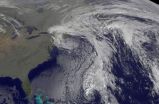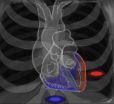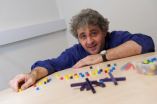(Press-News.org) A team of Italian scientists has fired a laser beam into a hunk of glass to create what they believe is an optical analogue of the Hawking radiation that many physicists expect is emitted by black holes. Although the laser experiment superficially bears little resemblance to ultra-dense black holes, the mathematical theories used to describe both are similar enough that confirmation of laser-induced Hawking radiation would bolster confidence that black holes also emit Hawking radiation.
When Stephen Hawking first predicted the radiation bearing his name in 1974, he hypothesized that photons could be spontaneously generated from the vacuum at the edge of a black hole. However, Hawking radiation emitted from a black hole would be so weak that many scientists believe it to be nearly impossible to detect.
Scientists have turned to lasers before in attempts to create Hawking radiation, but have had difficulty isolating Hawking radiation from other forms of light emitted during experiments. Franco Belgiorno et al. combined a tunable laser beam with a bulk glass target, which allowed them to limit the Hawking radiation to certain wavelengths of infrared light and to capture the apparent Hawking radiation with an infrared sensitive digital camera.
A paper describing the possible production of a laser induced analogue of Hawking radiation appears in the current issue of Physical Review Letters, and is the subject of a Viewpoint article by John Dudley (CNRS, France) and Dmitry Skryabin (University of Bath, UK) in this week's edition of Physics (physics.aps.org).
INFORMATION:
About Physics:
Physics (http://physics.aps.org) is a publication of the American Physical Society that provides expert written commentaries and highlights of papers appearing in the Society's journals.
Simulating black hole radiation with lasers
Lasers produce the first Hawking radiation ever detected
2010-11-09
ELSE PRESS RELEASES FROM THIS DATE:
Door-to-balloon time drops for heart attack patients, but mortality rates unchanged
2010-11-09
ANN ARBOR, Mich. - Door-to-balloon time has dropped dramatically as hospitals rush heart attack patients into treatment, but a five-year study released Monday shows quicker hospital care has not saved more lives.
Heart attacks are a medical emergency and hospitals race against the clock to open the clogged artery causing the attack in 90 minutes or less.
Door-to-balloon time is the amount of time between a heart attack patient's arrival at the hospital to the time he or she receives an intervention, such as a balloon angioplasty, to open the artery.
The study published ...
Special skin keeps fish species alive on land
2010-11-09
A new study shows how an amphibious fish stays alive for up to two months on land. It's all in the skin.
Mangrove killifish are small fish—only about an inch or two long—that live in temporary pools in the coastal mangrove forests of Central and South America and Florida. During dry seasons when their pools disappear, the fish hole up in leaf litter or hollow logs. As long as they stay moist, they can survive for extended periods out of water by breathing air through their skin. But oxygen isn't the only thing a fish out of water needs to worry about, according to Professor ...
UNC scientists identify cellular communicators for cancer virus
2010-11-09
Chapel Hill - A new discovery by UNC scientists describes how cells infected by the Epstein-Barr virus (EBV) produce small vesicles or sacs called exosomes, changing their cellular "cargo" of proteins and RNA. This altered exosome enters cells and can change the growth of recipient cells from benign to cancer-producing.
In this way, virus-infected cells can have wide-ranging effects and potentially manipulate other cells throughout the body. The findings are reported in the November 8, 2010 early online edition of the Proceedings of the National Academy of Sciences.
Nancy ...
Dangerous chemicals in food wrappers likely migrating to humans: U of T study
2010-11-09
University of Toronto scientists have found that chemicals used to line junk food wrappers and microwave popcorn bags are migrating into food and being ingested by people where they are contributing to chemical contamination observed in blood.
Perfluorinated carboxylic acids or PFCAs are the breakdown products of chemicals used to make non-stick and water- and stain-repellant products ranging from kitchen pans to clothing to food packaging. PFCAs, the best known of which is perfluorooctanoic acid (PFOA), are found in humans all around the world.
"We suspected that ...
GOES-13 satellite sees cold front stalking remnant low of Tomas
2010-11-09
The GOES-13 satellite is watching a flurry of activity in the Atlantic Ocean today as a cold front approaches the remnants of Hurricane Tomas and threatens to swallow it in the next couple of days.
Tomas is now a remnant low pressure area is located in the Atlantic near 26 North and 68 West hundreds of miles south-southwest of Bermuda and has a minimum central pressure of 994 millibars today, Nov. 8. A cold front off the U.S. East Coast however, is stalking Tomas' remnants and moving east threatening to swallow the former hurricane.
The Geostationary Operational Environmental ...
NASA sees Tropical Depression Jal's remnants entering and leaving India
2010-11-09
Jal was a tropical storm when it made landfall this weekend on the east coast of India and tracked across the country while weakening into a remnant low pressure area. NASA's Terra satellite captured an image of Jal's center as it was entering eastern India and NASA's Aqua satellite captured an infrared image as it was departing the country.
This weekend, Tropical Cyclone Jal made landfall in east central India and crossed the northern coast of Tamil Nadu and southern coast of Andhra Pradesh, north of Chennai. It dropped heavy rainfall and created some flooding. Gusty ...
Soy may stop prostate cancer spread
2010-11-09
CHICAGO --- Northwestern Medicine researchers at the Robert H. Lurie Comprehensive Cancer Center of Northwestern University have found that a new, nontoxic drug made from a chemical in soy could prevent the movement of cancer cells from the prostate to the rest of the body.
These findings will be presented at the Ninth Annual American Association for Cancer Research Frontiers in Cancer Prevention Research Conference.
Genistein, a natural chemical found in soy, is being used in the lab of Raymond Bergan, M.D., the director of experimental therapeutics at the Lurie Cancer ...
Fat sand rats are SAD like us
2010-11-09
Saying goodbye to summer can be difficult for everybody. In some people the onset of winter triggers Seasonal Affective Disorder, or SAD, a mood disorder in which sufferers experience symptoms of depression. Happily, a special kind of gerbil exhibits remarkably similar reactions to SAD treatments as humans, opening a promising new channel for study and treatment of the common complaint.
With her work on the Israeli desert inhabitant gerbil called the Fat Sand Rat (Psammomys obesus), Prof. Noga Kronfeld-Schor of Tel Aviv University's Department of Zoology and her fellow ...
UCLA uses new hybrid, precision heart procedures to help stop deadly arrhythmias
2010-11-09
New techniques now being used at UCLA allow doctors to more precisely target certain areas of the heart to stop ventricular arrhythmias — serious abnormal rhythms in the heart's lower chambers — in high-risk patients.
Generally, arrhythmias can be controlled by medications, and sometimes defibrillators. But a potentially life-threatening, recurrent arrhythmia known as a ventricular tachycardia, which originates in one of the heart's two ventricles, can produce a fast heart beat that requires other interventions, such as catheter ablation, in which the precise focus ...
Children find their own way to solve arithmetic problems
2010-11-09
Children with learning difficulties can benefit from being encouraged to find their own way to solve arithmetic problems, according to new research from the University of Strathclyde in Glasgow, Scotland.
A study by Dr Lio Moscardini, in Strathclyde's Faculty of Humanities & Social Sciences, found that children deal better with arithmetical problems if they can use their own intuitive strategies such as using number blocks, drawings or breaking an equation up into smaller, simpler parts- rather than being instructed in arithmetical facts and procedures.
All the teachers ...
LAST 30 PRESS RELEASES:
Smartwatch use enhances the detection of heart arrythmias, increasing the quality of care.
MAN PPK2: A “universal” enzyme for the production of RNA building blocks
Sniffing out the cause of keratoderma-associated foot odor
Tuning color through molecular stacking: A new strategy for smarter pressure sensors
Humans use local dialects to communicate with honeyguides
Theory-breaking extremely fast-growing black hole
ŌURA and National University of Singapore open Joint Lab to advance research in personalized preventive health
Hope for smarter lung cancer care
Singapore scientists discover lung cancer's "bodyguard system" - and how to disarm it
Bacteria use wrapping flagella to tunnel through microscopic passages
New critique prompts correction of high-profile Yellowstone aspen study, highlighting challenges in measuring ecosystem response to wolf reintroduction
Stroke survivors miss critical treatment, face greater disability due to systemic transfer delays
Delayed stroke care linked to increased disability risk
Long term use of anti-acid drugs may not increase stomach cancer risk
Non-monetary 'honor-based' incentives linked to increased blood donations
Natural ovulation as effective as hormones before IVF embryo transfer
Major clinical trial provides definitive evidence of impacts of steroid treatment on severe brain infection
Low vitamin D levels shown to raise risk of hospitalization with potentially fatal respiratory tract infections by 33%
Diagnoses of major conditions failing to recover since the pandemic
Scientists solve 66 million-year-old mystery of how Earth’s greenhouse age ended
Red light therapy shows promise for protecting football players’ brains
Trees — not grass and other greenery — associated with lower heart disease risk in cities
Chemical Insights scientist receives Achievement Award from the Society of Toxicology
Breakthrough organic crystalline material repairs itself in extreme cold temperatures, unlocking new possibilities for space and deep-sea technologies
Scientists discover novel immune ‘traffic controller’ hijacked by virus
When tropical oceans were oxygen oases
Positive interactions dominate among marine microbes, six-year study reveals
Safeguarding the Winter Olympics-Paralympics against climate change
Most would recommend RSV immunizations for older and pregnant people
Donated blood has a shelf life. A new test tracks how it's aging
[Press-News.org] Simulating black hole radiation with lasersLasers produce the first Hawking radiation ever detected





